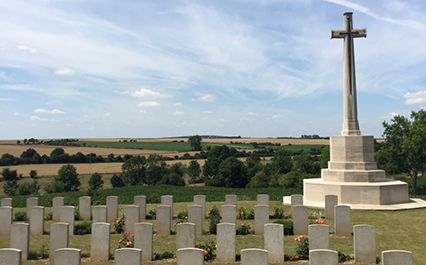Page Content
The Vimy Ridge memorial in northern France is a striking reminder of how relevant war continues to be for the people of that part of the world and of the obligation to continually safeguard our freedoms and democracy.
 As Remembrance Day approaches, teachers have the important task of conveying the significance of this day to our students. Often, we prepare a lesson or two surrounding the tragedy of wars, soldiers and the significance of the poppy. We
organize a Remembrance Day assembly at our schools and observe a moment of silence. While I have always been very passionate about teaching my students about war and the importance of Remembrance Day, it is challenging to make it relevant and relatable to students year after year. This all changed for me, however, after I travelled to France and Belgium this past summer.
As Remembrance Day approaches, teachers have the important task of conveying the significance of this day to our students. Often, we prepare a lesson or two surrounding the tragedy of wars, soldiers and the significance of the poppy. We
organize a Remembrance Day assembly at our schools and observe a moment of silence. While I have always been very passionate about teaching my students about war and the importance of Remembrance Day, it is challenging to make it relevant and relatable to students year after year. This all changed for me, however, after I travelled to France and Belgium this past summer.
For two weeks in July, I travelled to Europe as part of the War and the Canadian Experience: Teachers PD Tour of France and Flanders. I’d always wanted to engage in intensive PD on world war history that involved overseas travel, in order to see first hand the places I’d read and taught about, so to be accepted on this tour fulfilled a lifelong dream. Organized through the Gregg Centre at the University of New Brunswick, the tour involved 24 teachers from across Canada travelling the countryside of France and Belgium, investigating the battlefields of the world wars and digging deeply into Canada’s involvement in these momentous events.
One of the first things I realized while on the tour is that, for the people of France and Belgium, these wars are not a distant memory. Reminders and evidence are everywhere — monuments, memorials and cemeteries are found in almost every village and town, dotting the countryside, honouring the fallen. These commemorations are not left in disrepair or decay. All are very well maintained, with townspeople and tourists alike visiting them daily.
 The Canadian Courcelette War Memorial in northern France commemorates the Battle of the Somme in 1916.
The Canadian Courcelette War Memorial in northern France commemorates the Battle of the Somme in 1916.
One such active monument is the Menin Gate Memorial in Ypres, Belgium, where every night since 1928 townspeople and tourists have gathered at 8 p.m. to hear the “Last Post” and honour the fallen of the Great War. Looming large over the town, this spectacular monument bears the names of more than 54,000 Allied soldiers who have no known grave and stands as a reminder of the perils of war.
The evening that we attended the ceremony was rainy and cold, but more than 500 people attended. As I watched groups of youth lay wreaths at the cenotaph, I realized that the memory of the war lives on, not just in the older citizens of Belgium, but in youth everywhere, every day, and not just on Remembrance Day.
I also had no idea of the extent to which the French people continue to celebrate the contributions that Canadian soldiers made during wartime. For example, toward the end of our tour we visited Rocquancourt, a tiny village in Normandy that was occupied and decimated by German troops in the early days of the Allied invasion and liberated by Canadian soldiers in 1944.
Citizens of this village graciously hosted a reception for us. I was deeply moved when talking to three women, now in their 90s, about the atrocities they suffered during wartime. Although decades have passed, these women remembered it like it was yesterday, telling me details of what they witnessed and endured, such as being blown off their bikes by nearby bombshells and having to hide with their families for months in the underground mines. It made me realize that, although these women are nearing the end of their days, their memories must live on, as must the memory of the valiant Canadians who died liberating them.
It is up to us to teach our students about how this relates to their own lives, and the connection it has to the rest of the world and the human experience. We can do this by researching and reaching out to these villages and townspeople, as well as by having our students create biographies of Canadian soldiers from the world wars, which is a project that I and many of my tour mates are doing with our students this year.
This tour made me realize just how current and relevant war continues to be for the people of France and Belgium. Active monuments such as Menin Gate and villages such as Roquancourt need to be discussed in our classrooms as examples of the ongoing connection and remembrance of war. Moving forward, I will teach about Remembrance Day with renewed passion and tenacity, as I ask my students to remember the sacrifices that young Canadians made and to not take our freedoms and democracy for granted. ❚
Karen Porterfield is a Grade 7 learning and literacy teacher at Mc-Kenzie Highlands School in Calgary.
This opinion column represents the
views of the writer and does not necessarily reflect the position of the
Alberta Teachers’ Association.
